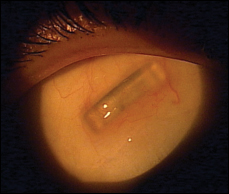Déjà vu all over again
To the Editor:
“Those who do not learn history are doomed to repeat it” (George Santayana).

The article, “Micro insert technology potential option for emmetropic presbyopes” (June 2018 issue) reminded me of these two sage observations. In the article, Jessica Heckman, OD, a sub-investigator, reports the results of clinical trials for the VisAbility Micro Insert System (Refocus Group, Dallas), a “new” scleral procedure for the correction of presbyopia.
In particular, it brought to mind a patient recently seen in our clinic for cataract evaluation. This 62-year-old female had bilateral radial keratotomy with enhancements and scleral implants in both eyes for the correction of presbyopia around 1992 in Atlanta. She reported that the scleral implants never provided good uncorrected near vision but did leave her with a constant foreign body sensation. Further, she could not find an ophthalmic surgeon willing to remove them. We removed the cataracts and the scleral implants. She returned to her referring doctor with good vision and much more comfortable eyes.
Perhaps there is something new about the VisAbility Micro Insert, but this approach to presbyopia correction has been tried and found wanting. I would not be surprised if it also landed on the heap of failed and discarded attempts to correct presbyopia.
Howell M. Findley, OD
Lexington, Ky.
hfindley@commonwealtheyes.com
Dr. Heckman responds:

Like all surgical device technologies, the VisAbility Micro Insert procedure has had its fair share of evolutionary changes in both application and design through the years. The implant depicted in the slit-lamp image you provided reflects a design of yesteryear. Today’s VisAbility Micro-Insert technology and procedure I speak of in my article has shown a significant increase in both ease of application and efficacy, most reflected in the data presented from our single-site involvement. Like all devices or therapeutic applications in medicine, none start off in “perfect form.” There was a history of rigorous testing, courage to make the needed design change and then more testing, all for the purpose of improved efficacy. The historical journey of the VisAbility Micro-Insert technology was no different. We have history to thank for the outcomes we celebrate today. The U.S. clinical trial is now complete, and all data has been submitted to the FDA for review as we look forward to this chapter of the VisAbility Micro Insert technology.
Jessica Heckman, OD
Bloomington, Minn.
